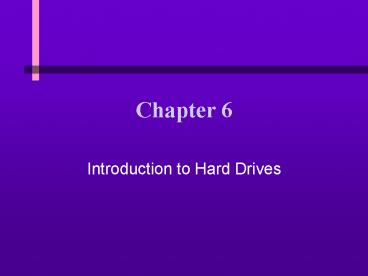Introduction to Hard Drives - PowerPoint PPT Presentation
1 / 30
Title:
Introduction to Hard Drives
Description:
How to use DOS and Windows commands to manage data on a hard drive ... Methods used to adjust for smaller tracks closer to center of platter. Write precompensation ... – PowerPoint PPT presentation
Number of Views:49
Avg rating:3.0/5.0
Title: Introduction to Hard Drives
1
Chapter 6
- Introduction to Hard Drives
2
You Will Learn
- How data is stored on a hard drive
- How to use DOS and Windows commands to manage
data on a hard drive - How to identify various types of hard drives and
understand advantages of each - How to manage a hard drive to optimize its
performance - How to compare different removable drives
3
Hard Drive Technology
4
Hard Drive Technology
5
Hard Drive Technology
- Methods used to adjust for smaller tracks closer
to center of platter - Write precompensation
- Reduced write current
6
Integrated Device Electronics (IDE) Technology
- A hard drive whose disk controller is integrated
into the drive - Eliminates need for controller cable
- Increases speed
- Reduces price
- OS does not communicate directly with the IDE
drive OS passes requests to the drive
controller, which is responsible for keeping up
with where and how data is stored on a drive - Most system boards provide one or two IDE
connections directly on system board
7
Hardware Subsystem with an IDE Hard Drive
8
Tracks and Sectors on an IDE Drive
- MFM and RLL technologies use either 17 or 26
sectors per track - Wastes drive space
- Number of bytes a track can hold is determined by
centermost track
9
Tracks and Sectors on an IDE Drive
- Use zone bit recording
- Tracks near center have smallest number of
sectors per track - Number of sectors increases as tracks get larger
- Have 512 bytes per sector for every sector on the
drive
10
Zone Bit Recording
11
Enhanced IDE (EIDE) Drives
- Support newer, faster drive standard that allows
systems to recognize drives larger than 504 MB
and to handle up to four devices on the same
controller
12
ANSI Standards for Hard Drives
13
SCSI (Small Computer Systems Interface) Technology
- Provides a standard for communication between a
subsystem of peripheral devices and the system
bus - Most SCSI drives are IDE drives
14
SCSI Technology
15
Differing SCSI Standards
- General categories
- Narrow (8 bits)
- Wide (16 bits)
- Ways a SCSI cable can be built
- Single-ended
- Differential
- Three major standards
- SCSI-1 (Regular SCSI)
- SCSI-2 (Fast SCSI)
- SCSI-3 (Ultra SCSI)
16
Summary of Different SCSI Standards
17
Sample Configuration of a SCSI Subsystem
18
Other Variations of SCSI Hardware and Software
- Termination
- Device drivers
- Host adapter issues
19
Termination
- Prevents an echo effect of power at the end of a
SCSI chain resulting in interference with the
data transmission - Several ways to terminate power
- Types of terminators
- Passive
- Active
- Forced perfect (more expensive and more reliable)
20
Termination
21
Termination
22
Device Drivers
- Advanced SCSI Programming Interface (ASPI)
- Common Access Method (CAM)
23
Host Adapter Issues
- Compare installation procedures and options
24
Comparing SCSI Hard Drives and EIDE Hard Drives
- SCSI costs more than EIDE but gives better
performance - SCSI provides faster data transfer
- SCSI bus supports multitasking EIDE processes
data from one I/O device at a time - SCSI host adapter allows connection to non-SCSI
devices - Without SCSI, if two IDE drives are on the same
adapter, only one can be busy at a time
25
Other Types of Hard Drive Interfaces
- IEEE 1394
- Also known as FireWire and i.Link
- Uses serial transmission of data
- Popular with multimedia and home entertainment
applications - Fibre Channel
- Designed for use in high-end systems that have
multiple hard drives (competes with SCSI) - Faster than SCSI when more than 5 hard drives are
strung together for massive secondary storage - Too expensive and has too much overhead for
desktop PC or workstation
26
How a Hard Drive Is Logically Organized to Hold
Data
- Steps in preparing a hard drive to hold data
- Low-level format
- Partitioning the hard drive
- High-level format
27
(No Transcript)
28
Hard Drive Partition Table
continued
29
Hard Drive Partition Table
30
Logical Drives































